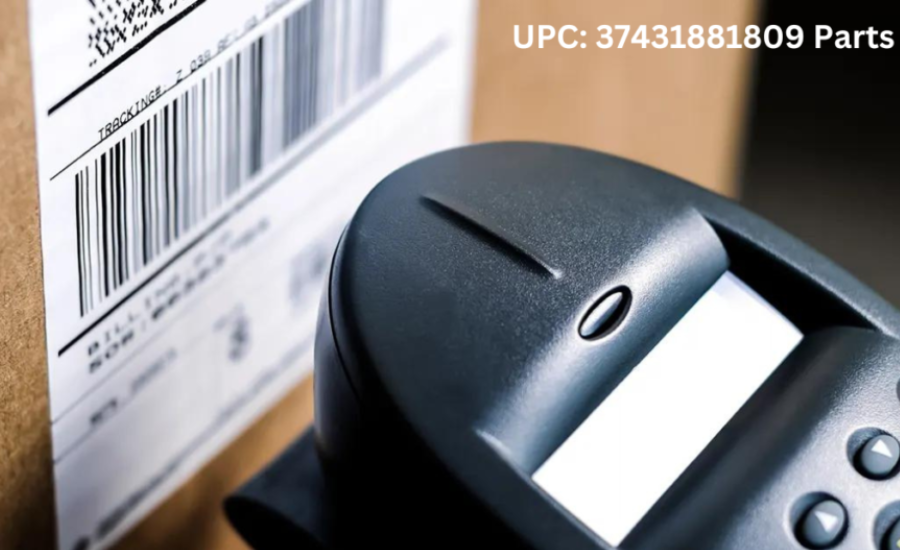“UPC 37431881809 Parts: “Enhancing Parts Tracking And Inventory Control”
Transforming Inventory Management: The Role Of UPC 37431881809

In the fast-paced world of modern commerce, businesses must prioritize efficiency, precision, and streamlined operations to thrive. As companies contend with the complexities of global supply chains, effective systems for managing inventory, tracking components, and facilitating smooth transactions have become essential. The introduction of the Universal Product Code (UPC) system has dramatically changed how goods are identified, monitored, and managed across various sectors. Notably, UPC 37431881809 exemplifies how a single code can profoundly influence parts identification and inventory control, revolutionizing the way businesses approach inventory management.
This article examines the transformative impact of UPC 37431881809 on parts tracking and inventory management. By investigating how this specific UPC enhances operational efficiency, we uncover the broader implications for businesses seeking to optimize their inventory processes and improve overall performance.
The Progression Of Parts Identification: A Historical Overview
Efficient parts identification has always been vital in commerce, dating back centuries. Initially, merchants managed their inventory through manual record-keeping methods, including handwritten ledgers and labels. While these early systems served their purpose, they were often fraught with inaccuracies and inefficiencies. As industrialization and global trade surged during the 19th and 20th centuries, the challenges of inventory management intensified. The increasing volume of goods required a more reliable and systematic approach to tracking and handling parts.
A pivotal advancement came in the 1970s with the advent of barcode technology. The Universal Product Code (UPC), created by George J. Laurer, represented a groundbreaking development in parts identification. This barcode system introduced a standardized method for encoding product information, enabling rapid and precise scanning. The UPC transformed retail and manufacturing by streamlining checkout procedures, minimizing human error, and enhancing inventory control. Over time, the UPC system has continued to evolve, integrating advanced technologies and broadening its use across various industries.
Decoding UPC 37431881809: A Comprehensive Look At Its Structure
UPC 37431881809 serves as a distinct identifier for products or components, encoded with critical information through a standardized format. This 12-digit numeric code is meticulously structured to facilitate accurate product identification.
Manufacturer Code: The initial six digits of UPC 37431881809 denote the manufacturer’s unique identification number, issued by the Uniform Code Council (UCC). This segment designates the producer or distributor of the product.
Product Code: The following five digits are assigned by the manufacturer to specify the individual item. Each product within a manufacturer’s range has a unique item number, allowing for precise identification and tracking.
Check Digit: The final digit, known as the check digit, is calculated using a checksum algorithm. This digit validates the accuracy of the entire UPC code, ensuring that any errors in scanning or data entry are detected and corrected.
Enhancing Precision In Parts Identification With UPC 37431881809
UPC 37431881809 has revolutionized parts identification across industries where precision is of utmost importance. In the automotive manufacturing sector, where the accurate tracking and matching of numerous components are critical, UPC 37431881809 offers a standardized solution. This consistency in part identification reduces the likelihood of errors, such as the installation of incorrect parts, thereby addressing potential safety concerns and improving overall operational accuracy.
Streamlining Inventory Management And Expanding Applications
In the electronics industry, known for its diverse and complex parts, UPC 37431881809 simplifies inventory management. By providing each component with a unique UPC, manufacturers and retailers can efficiently track parts from production to sale, ensuring accurate inventory levels and timely availability. This enhanced control is essential for meeting production schedules and maximizing profitability. Beyond automotive and electronics, the benefits of UPC 37431881809 extend to sectors like healthcare and aerospace, where its standardized approach aids in precise parts identification and contributes to overall operational efficiency and accuracy across various industries.
Mastering Inventory Control With UPC 37431881809
Effective inventory management presents a significant challenge for businesses, especially those handling extensive quantities of products and parts. Poor inventory control can result in issues such as stock shortages, excessive inventory, and missed sales opportunities, all of which can adversely affect a company’s financial performance. UPC 37431881809 has proven to be an invaluable asset in overcoming these challenges by providing a structured and dependable method for managing inventory.
A major advantage of utilizing UPC 37431881809 is its capacity to streamline and automate inventory tracking. Each time a product marked with UPC 37431881809 is scanned at a checkout or during inventory audits, the system promptly updates the inventory records. This real-time data synchronization helps businesses maintain precise stock levels, minimize errors, and ensure that products are readily available when required, thereby enhancing overall inventory efficiency and reliability.
Enhancing Inventory Management With UPC 37431881809
UPC 37431881809 offers significant benefits in streamlining the reordering process for parts and products. When integrated with advanced inventory management systems, this UPC code enables automated reordering. By setting predefined stock thresholds, companies can ensure that when inventory levels fall below these limits, the system automatically triggers a purchase order for restocking.
This automation not only improves efficiency but also mitigates the risk of stock shortages that could disrupt operations and result in lost sales.
Furthermore, UPC 37431881809 supports the implementation of advanced inventory control methods, such as Just-in-Time (JIT) inventory management. JIT aims to keep inventory levels as low as possible, ordering parts and products only as needed. This approach helps in reducing the costs related to excess inventory and minimizes the risk of product obsolescence. The accurate and timely data provided by UPC 37431881809 ensures that companies can effectively manage their inventory under JIT principles, maintaining operational efficiency and cost-effectiveness.
The Comprehensive Impact Of UPC 37431881809 On Business Operations
The influence of UPC 37431881809 extends well beyond its role in parts identification and inventory management. Its integration into business processes has far-reaching effects, particularly in terms of enhancing operational efficiency, reducing costs, and boosting customer satisfaction. Here’s a deeper look into these broader implications:
Boosting Operational Efficiency
UPC 37431881809 significantly enhances operational efficiency by automating inventory management and parts identification processes. This automation streamlines workflow, freeing employees from repetitive tasks and enabling them to focus on higher-value activities, such as enhancing customer service or innovation. Consequently, businesses experience faster turnaround times and can adapt more swiftly to shifts in customer demand or order volumes, ultimately improving their responsiveness and service levels.
Cutting Costs
Accurate inventory management facilitated by UPC 37431881809 leads to substantial cost savings. By keeping inventory levels in check, businesses can lower storage expenses and reduce the risk of holding obsolete stock. Additionally, automating inventory processes decreases the labor costs associated with manual stock management. The precision of UPC 37431881809 also minimizes errors in parts identification, preventing costly mistakes like incorrect shipments or returns, thereby further reducing operational costs.
Enhancing Customer Satisfaction
Effective inventory management directly impacts customer satisfaction. UPC 37431881809 provides real-time, accurate data about stock levels, helping businesses avoid stockouts and ensure that products are readily available to meet customer needs.
This reliability in product availability enhances the overall customer experience and fosters greater customer loyalty. When businesses consistently meet their customers’ needs, they build stronger, more lasting relationships, leading to repeat business and positive customer feedback.
Navigating The Challenges Of Implementing UPC 37431881809

Adopting UPC 37431881809 brings substantial advantages, but businesses must navigate several challenges to ensure a smooth and effective implementation. Addressing these issues thoughtfully is crucial for maximizing the benefits of this powerful inventory management tool.
Integrating With Existing Systems
A significant hurdle in implementing UPC 37431881809 is the integration with current inventory management and point-of-sale systems. For businesses with older, less compatible systems, integrating UPC technology can be particularly challenging. To address this, companies might need to update their infrastructure or invest in new software solutions that are designed to work seamlessly with UPC 37431881809. This integration is essential for realizing the full potential of UPC technology and ensuring operational continuity.
Training And Managing Change
The transition to using UPC 37431881809 often necessitates changes in established business processes, which can lead to resistance among staff. Successful implementation hinges on comprehensive training programs that demonstrate the benefits of the new system and teach employees how to use it effectively. Additionally, businesses should employ change management strategies to address any concerns and foster a positive attitude towards the new system. This proactive approach helps facilitate a smoother transition and encourages staff adoption.
Assessing Cost Implications
While the long-term cost savings associated with UPC 37431881809 can be significant, the initial investment can be considerable. Companies need to account for expenses related to purchasing barcode scanners, upgrading software, and providing employee training. It is important to evaluate these initial costs against the potential benefits, such as enhanced operational efficiency and reduced error rates, which can lead to considerable savings over time. Balancing these factors is key to making an informed decision about the implementation of UPC technology.
Ensuring Data Security And Privacy In UPC 37431881809 Implementation
Implementing UPC 37431881809 necessitates a strong focus on data security and privacy. Given that UPC systems involve the collection and processing of sensitive data, safeguarding this information from unauthorized access is crucial. Companies must adopt comprehensive security measures to protect data integrity and privacy, such as employing encryption techniques and establishing stringent access controls. These practices are vital for upholding customer trust and meeting regulatory standards.
The Integration Of UPC 37431881809 With Emerging Technologies
The future of UPC 37431881809 in inventory management is on the brink of significant evolution, largely due to advancements in technology and changing business needs. One of the most promising developments is the integration of UPC 37431881809 with Internet of Things (IoT) devices. IoT technologies, such as smart sensors and RFID tags, provide real-time data about inventory location and condition. This integration enables businesses to enhance visibility and control over their stock by automating inventory updates when items are moved within a warehouse. This shift not only reduces manual data entry but also improves accuracy and operational efficiency.
Advancements In AI, ML, And Sustainability
In addition to IoT, artificial intelligence (AI) and machine learning (ML) are poised to transform inventory management. These technologies can analyze large volumes of data generated by UPC 37431881809 to identify patterns and trends. Such analysis facilitates more informed decisions about stock levels, reorder points, and demand forecasting. For instance, AI-powered systems can predict potential stockouts by analyzing historical data, allowing businesses to reorder proactively.
Furthermore, with the growing emphasis on sustainability, UPC 37431881809 may play a role in tracking products throughout their entire lifecycle. This capability supports eco-friendly practices such as recycling and reuse, meeting the increasing demand for environmentally responsible business practices and providing customers with insights into the ecological impact of their purchases.
The Evolution And Impact Of UPC 37431881809
Origins And Development
UPC System: The Universal Product Code (UPC) was first introduced in the 1970s, with the first barcode scanned on June 26, 1974, at a supermarket in Troy, Ohio. The UPC was developed by George J. Laurer, among others, to provide a standardized method for product identification.
UPC 37431881809: This specific 12-digit UPC code represents a unique identifier for a product or part, allowing for precise tracking and management.
Structural Components
Manufacturer Code: The first six digits of UPC 37431881809 identify the manufacturer. This code is assigned by the Uniform Code Council (UCC) and ensures that each manufacturer has a unique identifier.
Product Code: The next five digits specify the individual item. Each product under a manufacturer’s code has a unique identifier to differentiate it from other items.
Check Digit: The final digit is used for error checking. It helps verify the accuracy of the UPC code to ensure it has been scanned or entered correctly.
Technological Integration and Advancements

Integration With IoT
IoT Devices: The Internet of Things (IoT) encompasses technologies like smart sensors and RFID tags that provide real-time data. Integrating UPC with IoT devices enhances inventory visibility and management by automatically updating records as items move within a warehouse.
AI And Machine Learning
Data Analysis: AI and machine learning can process large datasets from UPC codes to identify patterns and trends. This can improve decision-making in inventory management by predicting stock levels, reordering needs, and potential stockouts.
Forecasting: AI-driven systems can forecast demand and inventory needs based on historical data, leading to more proactive stock management.
Sustainability Considerations
Lifecycle Tracking: UPC codes can be used to track products from production through to disposal. This supports sustainable practices such as recycling and reuse by providing comprehensive data on a product’s lifecycle.
Environmental Impact: With a growing focus on sustainability, businesses are increasingly using UPC data to provide information on the environmental impact of their products, meeting consumer demand for eco-friendly practices.
Challenges And Considerations
System Integration
Legacy Systems: Integrating UPC technology with older inventory and point-of-sale systems can be complex. Businesses may need to upgrade their systems or adopt new software to ensure compatibility.
Training And Change Management
Employee Training: Successful implementation of UPC systems requires thorough training programs to help employees adapt to new processes and understand the benefits of the system.
Change Management: Effective change management strategies are necessary to address resistance and facilitate a smooth transition to new inventory management practices.
Cost Considerations
Initial Investment: The cost of implementing UPC systems includes purchasing barcode scanners, upgrading software, and training staff. Although these initial expenses can be high, the long-term benefits often outweigh the costs, providing significant operational efficiencies and cost savings.
Data Security And Privacy
Security Measures: Implementing UPC systems involves handling sensitive data, making data security a critical concern. Companies must use encryption and access controls to protect data integrity and comply with privacy regulations.
(FAQs) About UPC 37431881809 Parts
Q: What is UPC 37431881809?
A: UPC 37431881809 is a 12-digit Universal Product Code used to uniquely identify a product or component. This code facilitates inventory management by offering a standardized approach to tracking and identifying items.
Q: How does UPC 37431881809 improve inventory management?
A: UPC 37431881809 improves inventory management by providing accurate tracking of products and components. It supports automated updates, ensures real-time data synchronization, and reduces errors in parts identification, thereby enhancing overall inventory accuracy and efficiency.
Q: What are the parts of UPC 37431881809?
A: UPC 37431881809 is composed of three main segments:
- Manufacturer Code: The first six digits identify the manufacturer.
- Product Code: The next five digits specify the individual item.
- Check Digit: The final digit verifies the UPC code’s accuracy.
Q: How does UPC 37431881809 enhance operational efficiency?
A: UPC 37431881809 enhances operational efficiency by automating inventory processes, reducing manual errors, and maintaining accurate stock levels. This streamlining of operations helps businesses reduce turnaround times and adapt more swiftly to demand changes.
Q: What are the benefits of combining UPC 37431881809 with IoT and AI technologies?
A: Combining UPC 37431881809 with IoT and AI technologies improves inventory management by providing real-time data on inventory status and location. AI can use UPC data to forecast demand, detect patterns, and automate reordering, leading to better accuracy, efficiency, and decision-making.
Q: What challenges might arise when implementing UPC 37431881809?
A: Challenges in implementing UPC 37431881809 may include integrating the technology with existing systems, training employees on new processes, and managing initial costs for software, hardware, and training. Data security and privacy are also important considerations.
Q: How can companies address the challenges of implementing UPC 37431881809?
A: Companies can address these challenges by:
- Upgrading or investing in systems compatible with UPC technology.
- Providing thorough training and change management for staff.
- Planning for initial costs while considering long-term benefits.
- Implementing strong security measures to safeguard sensitive data.
Conclusion
UPC 37431881809 demonstrates the significant impact Universal Product Codes have on modern inventory management. By providing a standardized method for product identification, UPC 37431881809 greatly enhances operational accuracy, simplifies inventory processes, and supports integration with advanced technologies such as IoT and AI.
The advantages of UPC 37431881809 are evident across various industries, including automotive, electronics, healthcare, and aerospace. Its ability to automate tracking, minimize errors, and work with emerging technologies brings notable improvements in inventory management, efficiency, and cost reduction.
However, achieving these benefits involves addressing challenges related to system integration, employee training, and initial investment costs. By focusing on thoughtful planning, comprehensive training, and robust data security, businesses can leverage UPC 37431881809 to enhance their inventory management and overall performance.
As technology advances, UPC codes like 37431881809 will continue to play a crucial role in refining inventory management practices, enabling businesses to adapt to an ever-evolving and fast-paced market.
Stay in touch for more updates and alerts visit: Tech Trand!






